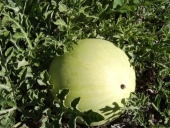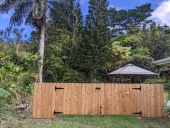


Since this picture has been taken I've gotten fruit set on almost all branches you see, the leaves have darkened and fruits are all bigger than marbles with maybe 16 in total. Now there's multiple branches sending out more blossoms as well as a few new branches so it seems to want to be an ever bloomer to some degree. I toss all kinds of stuff on this thing like plant tone organic fert, hefty layers of aged municipal compost, my own homemade compost with crushed charged biochar, nice layers of leaf mold from a tarp that sits under our jack fruit trees and forms leaf mold over time, banana stocks, albesia logs, lychee leaves, jackfruit leaves, bamboo leaves, papaya tree stalks, and anything that makes sense at the time and I have around. I don't put all that stuff on at once but those are the things it's been fed around it in it's lifetime so far. It was also planted over a couple of medium sized lava rocks so it will be harvesting minerals from those over time as the roots do their thing.May Lotito wrote:The tree has tripled in size in the past year. However, there's noticeable chlorosis in the younger leaves and that can affect fruit setting. Can you pinpoint which immobile element is low and fertilize accordingly?

Gop Xrock wrote:It does not look like a Tangelo. Tell me if it tasted like one. 1.5 years from seed, if it's a true Tangelo would be amazing. I grew blood orange from seeds (4 trees) and no fruits. It have been 7 - 8 years. It's 6 - 7 ft tall.


I've been shown the relief cut both in high end wood working to prevent blow out on the back side and in pruning to prevent peel off and obviously when felling a tree use a notch relief cut to prevent getting smooshed. To me it kind of sounds like your trying to mix the two worlds of wood working/carpentry with pruning techniques.Nancy Reading wrote:
George Booth wrote:Serious question, do you guys use the blades that are specialized for pruning? Here in Hawaii they don't sell them on the shelves of home depot or ace hardware so the majority of people are unaware they even exist and are always using the blades designed with teeth to cut through dried lumber, it bothers me in a pet peeve way because it'd be so easy to hop on Amazon and order a pack of the correct blade for the tool you already own. As far as straight cuts go I always use a relief cut on the opposite side so sometimes I get the angles mismatched and it's not straight but that's my own error, usually just having a good blade and utilizing the tools fence + some cutting techniques sometimes like see-sawing to lessen the amount of teeth cutting at the same.
It's a fairly coarse blade with coarse teeth flat on the outside on both sides and angled in the middle. A bit like my hand pruning saw, except that only cuts in the pull direction, whereas the reciprocating saw cuts in both directions. I have finer metal blades and a coarser 'demolition blade' for wood with nails.
When I'm felling the wood I use a cut on the opposite side to save excessive damage, but not for chopping to length. Thinking about it - my cutting the wood green is generally not quite so bad as now it has been stood a little while. Part of that may be that the trees don't rock around being rooted in the ground, but ergonomically it isn't always as good then of course.



